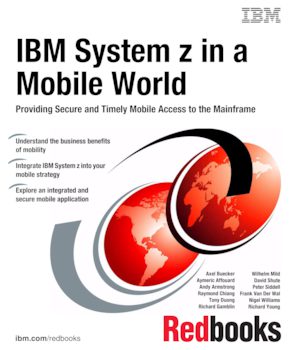
Published on 26 November 2014
Read in Google Books Order hardcopy
Share this page:
ISBN-10: 0738440094
ISBN-13: 9780738440095
IBM Form #: SG24-8215-00
Authors: Axel Buecker, Aymeric Affouard, Andy Armstrong, Raymond Chiang, Tony Duong, Richard Gamblin, Wilhelm Mild, David Shute, Peter Siddell, Frank Van Der Wal, Nigel Williams and Richard Young
Abstract
Today, organizations engage with customers, business partners, and employees who are increasingly using mobile technology as their primary general-purpose computing platform. These organizations have an opportunity to fully embrace this new mobile technology for many types of transactions, including everything from exchanging information to exchanging goods and services, from employee self-service to customer service. With this mobile engagement, organizations can build new insight into the behavior of their customers so that organizations can better anticipate customer needs and gain a competitive advantage by offering new services.
Becoming a mobile enterprise is about re-imagining your business around constantly connected customers and employees. The speed of mobile adoption dictates transformational rather than incremental innovation.
This IBM® Redbooks® publication has an end-to-end example of creating a scalable, secure mobile application infrastructure that uses data that is on an IBM mainframe. The book uses an insurance-based application as an example, and shows how the application is built, tested, and deployed into production. This book is for application architects and decision-makers who want to employ mobile technology in concert with their mainframe environment.
Table of Contents
Part 1. Understanding the business context in a mobile world
Chapter 1. Business drivers for a mobile enterprise
Chapter 2. Introducing IBM MobileFirst for enterprise mobile solutions
Chapter 3. Bridging the gap from mobile to transactional systems
Chapter 4. IBM Worklight: The foundation for mobile solutions
Part 2. Designing and planning the solution
Chapter 5. Deployment model for a mobile solution on IBM System z
Chapter 6. The mobile enterprise architecture IBM System z
Chapter 7. Designing for resilience
Chapter 8. Designing for security
Part 3. Customer scenario
Chapter 9. Overview of scenario, requirements, and approach
Chapter 10. Agile approach to deliver application functionality
Chapter 11. Enabling end-to-end security
Chapter 12. Deploying the mobile app in to an HA infrastructure
Chapter 13. Mobile analytics
Appendix A. Additional material